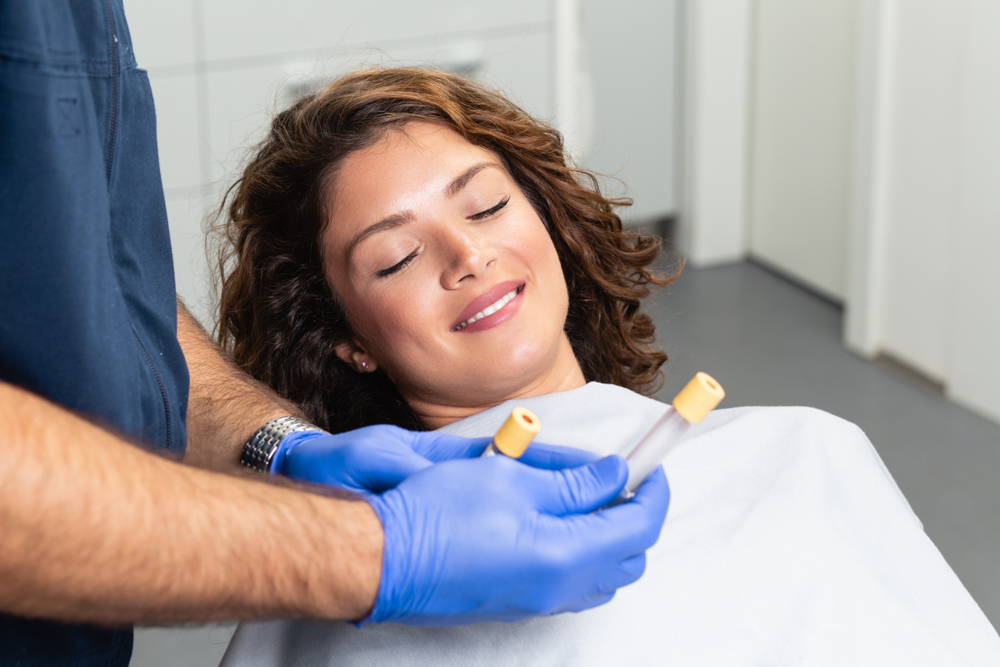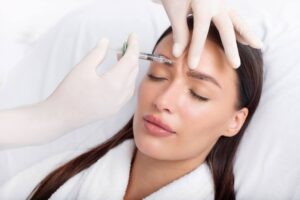PRP (platelet-rich plasma) therapy is a way to “supercharge” your body’s natural healing potential by using your own blood platelets to promote recovery and renewal.
You may not have heard much about this modern treatment—or maybe you only know about it from the celebrity “vampire facial” photos that made waves on social media. But PRP therapy goes far beyond aesthetics.
While it might not make headlines or top your Instagram explore feed, platelet-rich plasma has many applications that can transform your health.
PRP doesn’t just enhance how you look—it can also transform how you feel and function, aiding with injury recovery, pain relief, and more.
What is PRP Therapy?
Our bodies have a lot of natural healing power. Sometimes, they just need a little boost in the right direction. That’s essentially the science behind Platelet-Rich Plasma (PRP) therapy. This advanced, natural medical treatment enhances healing through its interaction with cellular processes.
It involves concentrating platelets—which release growth factors that recruit stem cells, enhance collagen production, and improve blood flow—and applying them to the treated area to help support and accelerate the body’s natural repair process.
There are several types of growth factors involved in this process:
- Platelet-derived growth factor (PDGF): Important for helping cells multiply and grow. When you get hurt, this growth factor encourages cells to divide and repair damaged tissue. It plays a big part in building new tissue and healing wounds, guiding cells to the injured area to help with the repair process.
- Vascular endothelial growth factor (VEGF): Helps create new blood vessels, a process called angiogenesis. After an injury, your body needs more blood to carry oxygen and nutrients to the damaged area. VEGF helps form these new blood vessels, which is essential for healing and ensuring the tissues get everything they need to repair themselves.
- Transforming growth factor-beta (TGF-β): Plays a crucial role in tissue repair. It helps guide the healing process by supporting the formation of scar tissue, which is essential for closing up the wound. TGF-β also helps reduce inflammation, allowing the body to focus on rebuilding healthy tissue and ensuring the area heals properly.
If your body does all this naturally, you might wonder why PRP therapy is necessary. That’s a good question!
PRP therapy amplifies this natural process and delivers a concentrated dose of your own platelets exactly where they’re needed. We’ll explain the PRP therapy process step-by-step a little further down, but it’s really safe and simple.
PRP therapy starts with a simple blood draw. Your blood is then processed to separate the platelets from other components. What’s left is the good stuff—your own platelet-rich plasma, which is then carefully injected into the target areas.
PRP therapy stands out as a treatment for anything from an injured joint or muscle to thinning hair or areas of the skin that need rejuvenation because it’s entirely natural. It uses nothing but your own blood to kickstart the healing process.
What is PRP Therapy Used For?
PRP therapy is probably most recognized for its use in skin aesthetics. This is primarily due to the popularity of the “vampire facial,” a type of PRP treatment made famous by celebrities.
But PRP isn’t just for beauty treatments. Platelet-rich plasma has many other uses and is transforming the way many health conditions are managed.
Here are some of the most common areas where PRP therapy is being used:
PRP for Skin Health and Skin Rejuvenation
Let’s start with what PRP is most famous for… skin health! We all want to look youthful and radiant, and PRP can help. PRP therapy is a popular method for improving skin texture, reducing scars, and minimizing wrinkles.
It works by stimulating collagen production, which enhances the skin’s elasticity and firmness. It also promotes cell turnover, encouraging new, healthy skin cells to replace older, damaged ones.
Some examples of skin concerns that PRP therapy can help improve are:
- Fine lines and wrinkles
- Sagging skin
- Scars (acne, surgical, etc.)
- Stretch marks
- Enlarged pores
- Skin texture
- Hyperpigmentation
- Sun damage
PRP for skin isn’t only about beauty. Due to its regenerative properties, PRP therapy can potentially help those with:
- Skin ulcers
- Rosacea
- Psoriasis
- Atopic dermatitis
- Wounds
It is important to consult with your doctor before undergoing PRP for certain skin conditions and always consult with a professional trained in PRP to determine if it is right for you.
PRP for Joint and Muscle Pain Relief
Achy joints or muscle pain can make it hard to get out of bed most days and turn the simplest tasks into a challenge. For athletes and those leading active lifestyles, these aches and pains can also cause frustrating setbacks in training.
There are several ways to support healthy joints and relieve muscle pain, including pain medications, collagen supplements, and ozone therapy. However, PRP therapy offers a natural, targeted approach to finding relief.
By focusing on the source of pain with concentrated growth factors, PRP can help reduce inflammation and promote tissue repair.
Examples include joint and muscle pain from things such as:
- Neck and back pain
- Degenerative joint issues
- Autoimmune disorders
- Rheumatic conditions
- Infections
- Joint related injuries
- Tendonitis
- Overuse from repetitive motions
PRP therapy is helping thousands of people naturally manage pain from joint and muscle issues. That said, it’s not a cure-all. PRP therapy is most effective for mild to moderate pain related to minor and early-stage conditions.
PRP for Thinning Hair or Balding
PRP therapy is a preferred treatment for those experiencing thinning hair or balding. When injected into the scalp, PRP targets the hair follicles, delivering growth factors that can stimulate hair follicles and prolong the hair growth cycle, encouraging natural growth for thicker, fuller hair.
Common hair concerns that PRP therapy can help correct include:
- Hereditary balding
- Thinning hair
- Receding hairlines
- Female pattern hair loss
- Hormonal hair loss
- Alopecia
PRP therapy is most effective for individuals with thinning hair or early-stage hair loss where hair follicles remain active. It is less effective for advanced balding where follicles are no longer viable.
PRP for Sports and Injury Recovery
When injuries happen, the first thing on most people’s minds, especially athletes or those who are extremely active, is getting back in the game or simply back to their routine.
PRP is a favorite therapy to speed up recovery. By promoting faster tissue repair and reducing inflammation, PRP helps minimize downtime and can get you back to full activity, often without invasive interventions.
In addition to promoting faster recovery, PRP can also improve function and reduce pain in people who have sustained an injury.
Common injuries that PRP therapy can help with include:
- Sprains and strains
- Ligament injuries
- Tendon injuries
- Muscle injuries
- Rotator cuff injuries
- Golfer/Tennis elbow
This is just a small list. While PRP injections are primarily used for soft tissue injuries, their use in a wide range of injuries is becoming more common.
PRP is natural and considered generally safe when performed by a trained professional. However, if you have sustained an injury, it is always smart to consult with your doctor or surgeon before undergoing alternative treatments.
Other Potential Uses of PRP Therapy
Many fields of medicine are becoming more and more curious about PRP therapy due to its ability to amplify the body’s natural repair processes.
Emerging research suggests PRP therapy may have potential in areas like improving sexual wellness, dental regeneration, and inflammatory conditions, though further studies are needed.
Benefits of PRP Therapy
The exact benefits of PRP therapy will vary depending on the specific condition and the area of the body receiving the treatment. For example, someone using PRP for hair restoration may experience regrowth and thicker hair, while someone using it for joint pain may see a reduction in discomfort and improved mobility.
Despite the differences in outcomes, several core benefits of PRP therapy apply across the board, making it a highly versatile treatment option.
Some of the key benefits of PRP therapy include:
Natural Healing
Unlike treatments that rely on synthetic substances or foreign materials, PRP uses your body’s own platelets for healing. It can’t get any more natural than that!
Safe
PRP injections are generally considered safe because they use your blood, reducing the likelihood of adverse reactions or rejection. There are potential risks, such as localized infection, nerve damage, or increased pain at the injection site. However, these rare when performed by a trained professional.
Minimal to No Downtime
There might be some short-term limitations based on where the PRP is injected, but PRP therapy doesn’t require much downtime or recovery. Most people immediately return to work and can resume all normal activities.
Your injector will provide detailed dos and don’ts following PRP therapy that are custom to your treatment. For example, you might be advised to take it easy and avoid intense exercise or activities for a day or two after treatment. Or, if you are getting PRP on your face, you might be asked to avoid sun exposure and not use harsh products for a few days if you are getting PRP therapy on your face.
Quick Treatment
PRP therapy is generally a fast, in-office procedure that can often be completed in less than an hour. Many of our patients pop in on their way to work or even during their lunch break.
Non-Surgical
A needle prick is the extent of invasiveness with PRP therapy! PRP is a non-invasive therapy, so there’s no need for incisions, stitches, or long recovery times.
Painless
Pain can vary based on the patient’s individual pain tolerance and the area of the body in which the injection is being made. However, other than slight discomfort during the blood draw, you shouldn’t experience any discomfort. Most describe the PRP therapy procedure itself as painless.
Fast Results
Notice we said fast, not instant. In some applications, such as PRP therapy for the skin, there are often immediately noticeable results, such as a more youthful appearance or smoother skin texture.
However, PRP is a long-acting treatment, so you may not immediately see significant results, especially when used for injury recovery. In most cases, patients notice improvements within a week or so, with full results often visible in 2-3 months, particularly for joint health or hair restoration.
Long-Lasting
Most PRP treatments are not permanent, but they can offer long-term benefits. The length of time between treatments and the frequency of follow-up treatments depend on the condition and your body’s individual response to the therapy.
Once all necessary treatments are complete, some treatments may last 6 months before requiring a follow-up appointment, while the effects of others, like hair restoration, can last for years with proper maintenance.
Can Be Combined with Other Therapies
Because PRP is a natural therapy that uses your body’s own platelets, there are very few restrictions on combining it with other therapies.
For example, if you have an injury or muscle strain, many people combine PRP therapy with physical therapy or ozone therapy to enhance recovery and improve outcomes.
If you receive a PRP facial treatment, it can often be combined with other popular aesthetic treatments like Botox or dermal filler.
If hair loss is your concern, PRP therapy is commonly used alongside topical treatments like minoxidil or oral medications to improve results.
What to Expect During PRP Therapy
In most cases, booking a consultation before treatment is recommended to determine if PRP therapy is right for you. If you are seeking PRP therapy for an injury or medical condition, it is also advisable to consult with your healthcare provider to ensure the treatment aligns with your specific needs.
PRP therapy itself is quick and straightforward. The treatment begins with a simple blood draw, similar to what you would experience during routine lab work or blood donation.
Your blood is then processed to separate the platelets from other components. What remains is platelet-rich plasma, which is then injected into the targeted treatment area, often with the help of imaging tools for accuracy.
From start to finish, most PRP treatments take less than an hour and typically involve minimal downtime. You will be provided with any necessary post-treatment instructions and follow-up care.
Most people require a few sessions to see optimal results. The timing of your next appointment will depend on the nature of your treatment and how your body responds to the therapy.
Is PRP Therapy Safe?
One advantage of PRP is that it uses your own platelets, significantly reducing the risk of allergic reactions or complications.
While PRP is generally safe, potential risks include localized infection, nerve damage, or increased pain at the injection site, though these are rare when performed by trained professionals.
Does PRP Therapy Have Any Side Effects?
PRP therapy is well-tolerated with minimal side effects. Serious side effects and adverse reactions are extremely rare. However, like any procedure that involves injections, there are a few potential, temporary side effects to be aware of.
The most common side effects of PRP therapy include mild bruising, swelling, and redness at the injection site. These are usually short-lived and should subside within a few hours to a few days at most.
Some people may also experience slight discomfort or tenderness in the treated area, which is also typically mild and temporary. It’s also possible to experience a feeling of tightness, especially with facial treatments.
Final Thoughts on PRP Therapy
Millions of people wake up every day dealing with aches and pains, whether from aging or chronic conditions. On top of that, countless others are recovering from injuries, surgeries, or other medical procedures.
Regardless of the cause, pain and discomfort take a serious toll on most people’s overall quality of life at some point in their lives. Traditional treatments don’t always offer enough relief. Plus, many come with unwanted side effects, including the potential for addiction or dependency.
PRP therapy stands out as a modern, all-natural alternative. Using your body’s healing potential, PRP helps improve how you feel and function—without anything foreign or artificial.
Find PRP Therapy Near You
Relive Health is thrilled to add PRP therapy to its menu of personalized health and medical services. Use our clinic locator to find a Relieve Health clinic near you and our team of experienced medical professionals will evaluate your needs to determine if PRP therapy is the best therapy option for you.




